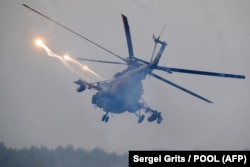Russian President Vladimir Putin on September 18 attended a joint military exercise with Belarus near NATO’s eastern flank that has fanned already deep tensions between Moscow and the West.
Putin took in the Zapad (West) 2017 exercise, scheduled from September 14 to 20 in Belarus and parts of western Russia, at the Luzhsky range about 100 kilometers east of the Estonian border.
Russia also test-fired a state-of-the-art cruise missile at a mock target in Kazakhstan as part of the exercises, in a show of the weapon’s long range and accuracy.
The war games are officially set to involve 12,700 troops, but Western officials have said the maneuvers could include some 100,000 personnel in what they call a Russian show of power amid the ongoing standoff with the West over Russian aggression in Ukraine.
Lithuanian President Dalia Grybauskaite was among those who voiced alarm about Zapad 2017, saying the military exercises are a sign that Russia is preparing for a serious conflict with NATO.
"We are anxious about this drill...it is an open preparation for war with the West," she told reporters.
Poland's National Security Bureau head, Pawel Soloch, told private Radio Zet that the exercises are a demonstration "of the Russian state's capacity to hold full-scale war action."
Russia, meanwhile, has pushed back against what it portrays as Western alarmism over the drills, the first to be held in close proximity to NATO member states since Russia annexed Ukraine's Crimea in 2014.
Moscow insists that the size of the exercises will not cross the 13,000-troop threshold that, under Organization for Security and Cooperation in Europe (OSCE) rules known as the Vienna Document, would require it to notify other nations and open the maneuvers to observers.
NATO is closely watching the exercises and says they are larger than the 12,700 servicemen Moscow has publicized, actually numbering some 100,000 troops, and involve firing nuclear-capable ballistic missiles.
The chief of Russia's general staff, General Valery Gerasimov, sought to reassure his NATO counterpart late on September 14 that the exercise is purely defensive, Russian news agencies reported.
In a phone call, Gerasimov informed NATO Supreme Allied Commander in Europe Curtis Scaparrotti that the war games had officially begun and are "exclusively defensive in nature" and "not targeted against any third parties," Russian media quoted the Russian Defense Ministry as saying.
Kremlin spokesman Dmitry Peskov earlier accused the West of "whipping up hysteria" over its military exercises.
"We reject complaints of these exercises not being transparent," Peskov told a conference call with reporters. "We believe that whipping up hysteria around these exercises is a provocation."
Colonel General Andrei Kartapolov, commander of Russia’s Western Military District, said in an interview published by the Russian military’s official Krasnaya Zvezda newspaper on September 13 that the number of troops and hardware used in the drills “will fully comply with the Vienna Document.”
The Zapad exercise is held every four years in rotation with drills in other parts of Russia.
Western governments have responded to Russia’s 2014 seizure of Ukraine’s Crimean Peninsula and backing of separatists in eastern Ukraine with several waves of economic and other sanctions targeting Moscow.
NATO has also bolstered its presence in its easternmost member states that were dominated by Moscow during the Cold War and remain concerned about the Kremlin’s intentions in the region.
Belarus, where part of the Zapad 2017 exercise is being held, borders Ukraine as well as NATO members Poland, Lithuania, and Latvia. The drills are also being staged in Russia’s western exclave of Kaliningrad, which lies between Poland and Lithuania on the Baltic Sea.
NATO Secretary-General Jens Stoltenberg said in Estonia last week that the military alliance would send three observers.
“But these invitations fall short from the transparency required by the OSCE: briefings on the exercise scenario and progress, opportunities to talk to individual soldiers and overflights of the exercise,” Stoltenberg told reporters on September 6 during his visit to a NATO contingent in Tapa, Estonia.
"We will monitor the [Zapad 2017] activity closely, and we are vigilant but also calm, because we don't see any imminent threat against any NATO ally," Stoltenberg added.
In an interview with Reuters in Berlin, Ukrainian President Petro Poroshenko's foreign policy adviser Kostiantyn Yeliseyev said on September 14 that Zapad 2017 is “very dangerous since they are taking place just near the border with Ukraine.”
Yeliseyev added that the exercises’ purpose is to “destabilize the military situation close to the border with NATO member states” and to “keep as long as possible Russian military troops and weaponry near the [Ukrainian] border and then to use them as a platform for a possible future offensive operation.”
Russia, which has repeatedly accused NATO of stoking regional tensions through enlargement after the fall of the Iron Curtain and deployments in Eastern Europe in the aftermath of the Ukraine crisis, has called Western concerns about the Zapad drills baseless, saying the exercise is "purely defensive."
Fictitious Enemy
Kartapolov told Krasnaya Zvezda that in addition to the stated 12,700 troops -- around 7,200 from Russia and 5,500 from Belarus -- Zapad 2017 includes about 70 aircraft and up to 680 pieces of military hardware, including tanks, artillery units, and ships.
During the drills, the joint Russian-Belarus operations are targeting a theoretical adversary attempting to undermine the government in Minsk and establish a separatist stronghold in western Belarus.
This scenario echoes Russian concerns over what Moscow calls Western-orchestrated political revolutions in its backyard, most notably in Georgia in 2003 and in Ukraine, where President Viktor Yanukovych, a Kremlin ally, was ousted in early 2014.
The United States and the European Union have repeatedly rejected such allegations, calling those events the result of grassroots anger against corrupt regimes in the former Soviet republics.











